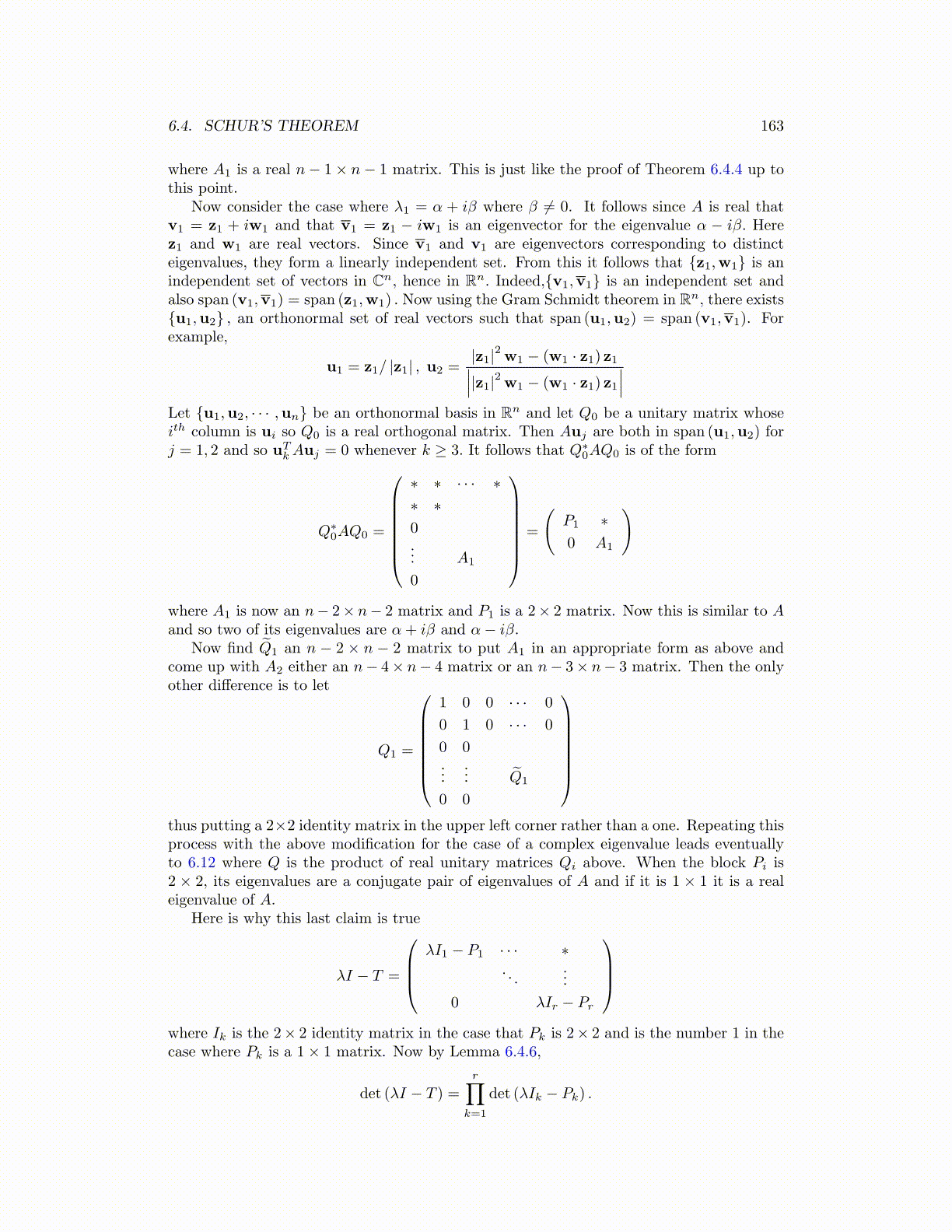
6.4. SCHUR’S THEOREM 163
where A1 is a real n− 1× n− 1 matrix. This is just like the proof of Theorem 6.4.4 up tothis point.
Now consider the case where λ1 = α + iβ where β ̸= 0. It follows since A is real thatv1 = z1 + iw1 and that v1 = z1 − iw1 is an eigenvector for the eigenvalue α − iβ. Herez1 and w1 are real vectors. Since v1 and v1 are eigenvectors corresponding to distincteigenvalues, they form a linearly independent set. From this it follows that {z1,w1} is anindependent set of vectors in Cn, hence in Rn. Indeed,{v1,v1} is an independent set andalso span (v1,v1) = span (z1,w1) . Now using the Gram Schmidt theorem in Rn, there exists{u1,u2} , an orthonormal set of real vectors such that span (u1,u2) = span (v1,v1). Forexample,
u1 = z1/ |z1| , u2 =|z1|2 w1 − (w1 · z1) z1∣∣∣|z1|2 w1 − (w1 · z1) z1
∣∣∣Let {u1,u2, · · · ,un} be an orthonormal basis in Rn and let Q0 be a unitary matrix whoseith column is ui so Q0 is a real orthogonal matrix. Then Auj are both in span (u1,u2) forj = 1, 2 and so uT
kAuj = 0 whenever k ≥ 3. It follows that Q∗0AQ0 is of the form
Q∗0AQ0 =
∗ ∗ · · · ∗∗ ∗0... A1
0
=
(P1 ∗0 A1
)
where A1 is now an n− 2× n− 2 matrix and P1 is a 2× 2 matrix. Now this is similar to Aand so two of its eigenvalues are α+ iβ and α− iβ.
Now find Q̃1 an n − 2 × n − 2 matrix to put A1 in an appropriate form as above andcome up with A2 either an n− 4× n− 4 matrix or an n− 3× n− 3 matrix. Then the onlyother difference is to let
Q1 =
1 0 0 · · · 0
0 1 0 · · · 0
0 0...
... Q̃1
0 0
thus putting a 2×2 identity matrix in the upper left corner rather than a one. Repeating thisprocess with the above modification for the case of a complex eigenvalue leads eventuallyto 6.12 where Q is the product of real unitary matrices Qi above. When the block Pi is2 × 2, its eigenvalues are a conjugate pair of eigenvalues of A and if it is 1 × 1 it is a realeigenvalue of A.
Here is why this last claim is true
λI − T =
λI1 − P1 · · · ∗
. . ....
0 λIr − Pr
where Ik is the 2× 2 identity matrix in the case that Pk is 2× 2 and is the number 1 in thecase where Pk is a 1× 1 matrix. Now by Lemma 6.4.6,
det (λI − T ) =
r∏k=1
det (λIk − Pk) .